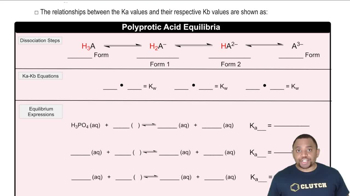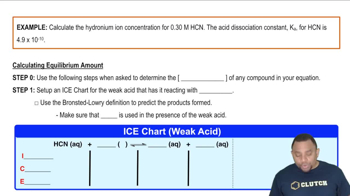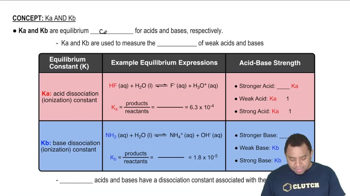Calculate the concentration of an aqueous solution of Ca1OH22 that has a pH of 10.05.
Lactic acid CH3CH(OH)COOH has one acidic hydrogen. A 0.10 M solution of lactic acid has a pH of 2.44. Calculate Ka.
 Verified step by step guidance
Verified step by step guidanceKey Concepts
Acid-Base Equilibrium

pH and Hydronium Ion Concentration

Acid Dissociation Constant (Ka)

Write the chemical equation and the Ka expression for the acid dissociation of each of the following acids in aqueous solution. First show the reaction with H+(a)q as a product and then with the hydronium ion: (a) C6H5COOH (b) HCO3-
Phenylacetic acid 1C6H5CH2COOH2 is one of the substances that accumulates in the blood of people with phenylketonuria, an inherited disorder that can cause mental retardation or even death. A 0.085 M solution of C6H5CH2COOH has a pH of 2.68. Calculate the Ka value for this acid.
A 0.100 M solution of chloroacetic acid 1ClCH2COOH2 is 11.0% ionized. Using this information, calculate 3ClCH2COO-4, 3H+4, 3ClCH2COOH4, and Ka for chloroacetic acid.
A 0.100 M solution of bromoacetic acid 1BrCH2COOH2 is 13.2% ionized. Calculate 3H+4, 3BrCH2COO-4, 3BrCH2COOH4 and Ka for bromoacetic acid.
